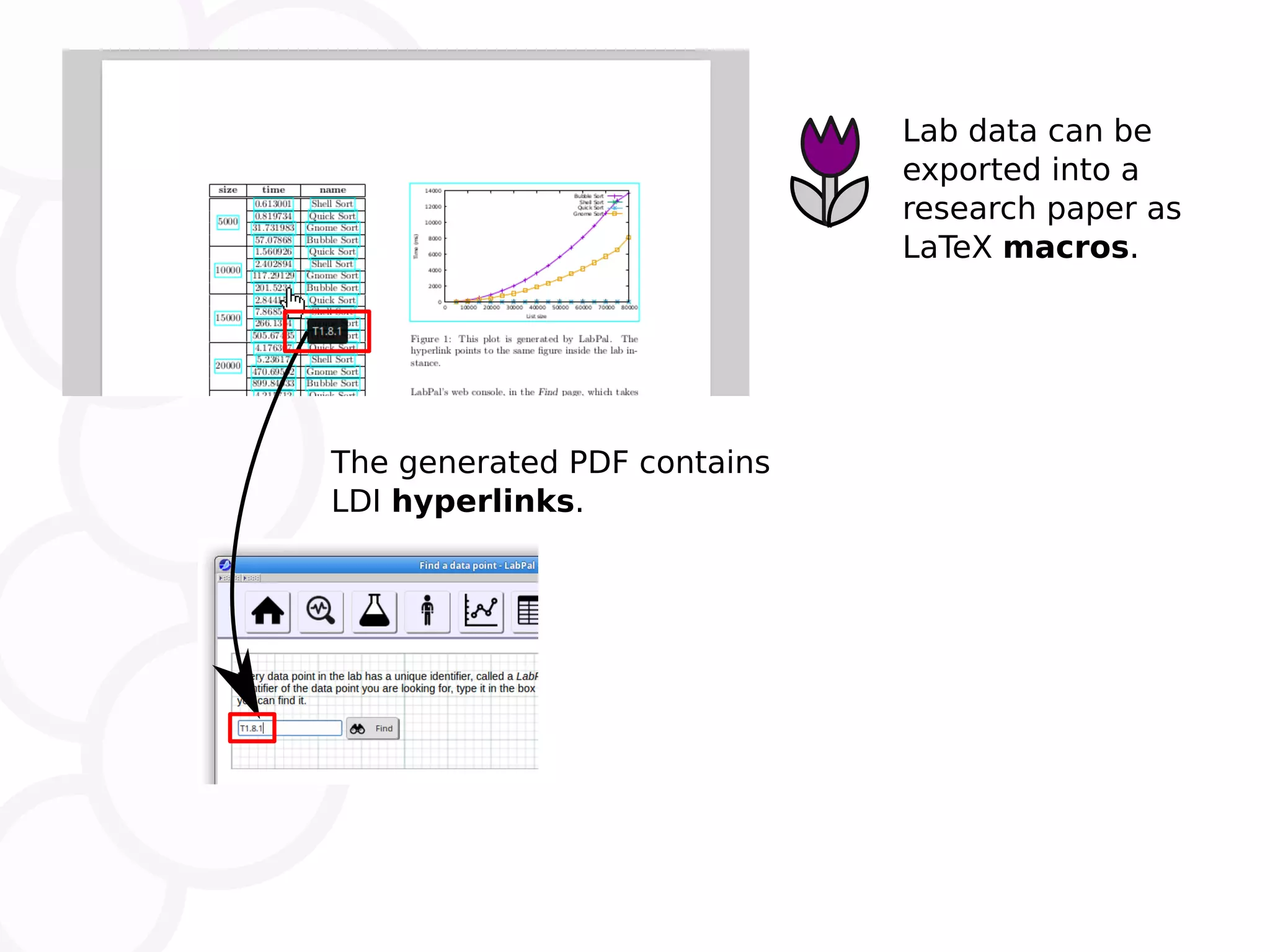The document discusses the LabPal framework for conducting repeatable computer experiments, emphasizing the structure and functionality of experiments, tables, and laboratories. It outlines the ability to execute experiments with specific input parameters, transform tables, and track data points to their source experiments. Additionally, it highlights the capability to export lab data as LaTeX macros for research papers.

![E1 t=2 x=[3,1,0.3] u=http://... k=0.239 z=["foo","bar"] An experiment is an object that takes input parameters, can be executed, and produces output parameters.](https://image.slidesharecdn.com/labpal-slides-171207151040/75/LabPal-Repeatable-Computer-Experiments-Made-Easy-ACM-Workshop-Talk-2-2048.jpg)
![E1 t=2 x=[3,1,0.3] u=http://... k=0.239 z=["foo","bar"] E1 t=5 x=[6,2,0.2] u=http://... E2q=0 f="foo" ... An experiment is an object that takes input parameters, can be executed, and produces output parameters.](https://image.slidesharecdn.com/labpal-slides-171207151040/75/LabPal-Repeatable-Computer-Experiments-Made-Easy-ACM-Workshop-Talk-3-2048.jpg)
![E1 t=2 x=[3,1,0.3] u=http://... k=0.239 z=["foo","bar"] E1 t=5 x=[6,2,0.2] u=http://... E2q=0 f="foo" ... t z b A table is a collection of parameters from a set of experiments. Tables can be transformed, combined and displayed. An experiment is an object that takes input parameters, can be executed, and produces output parameters.](https://image.slidesharecdn.com/labpal-slides-171207151040/75/LabPal-Repeatable-Computer-Experiments-Made-Easy-ACM-Workshop-Talk-4-2048.jpg)
![E1 t=2 x=[3,1,0.3] u=http://... k=0.239 z=["foo","bar"] E1 t=5 x=[6,2,0.2] u=http://... E2q=0 f="foo" ... t z b A table is a collection of parameters from a set of experiments. Tables can be transformed, combined and displayed. An experiment is an object that takes input parameters, can be executed, and produces output parameters.](https://image.slidesharecdn.com/labpal-slides-171207151040/75/LabPal-Repeatable-Computer-Experiments-Made-Easy-ACM-Workshop-Talk-5-2048.jpg)
![E1 t=2 x=[3,1,0.3] u=http://... k=0.239 z=["foo","bar"] E1 t=5 x=[6,2,0.2] u=http://... E2q=0 f="foo" ... t z b SUM A table is a collection of parameters from a set of experiments. Tables can be transformed, combined and displayed. An experiment is an object that takes input parameters, can be executed, and produces output parameters.](https://image.slidesharecdn.com/labpal-slides-171207151040/75/LabPal-Repeatable-Computer-Experiments-Made-Easy-ACM-Workshop-Talk-6-2048.jpg)
![E1 t=2 x=[3,1,0.3] u=http://... k=0.239 z=["foo","bar"] E1 t=5 x=[6,2,0.2] u=http://... E2q=0 f="foo" ... t z b SUM JOIN A table is a collection of parameters from a set of experiments. Tables can be transformed, combined and displayed. An experiment is an object that takes input parameters, can be executed, and produces output parameters.](https://image.slidesharecdn.com/labpal-slides-171207151040/75/LabPal-Repeatable-Computer-Experiments-Made-Easy-ACM-Workshop-Talk-7-2048.jpg)
![E1 t=2 x=[3,1,0.3] u=http://... k=0.239 z=["foo","bar"] E1 t=5 x=[6,2,0.2] u=http://... E2q=0 f="foo" ... t z b SUM JOIN A table is a collection of parameters from a set of experiments. Tables can be transformed, combined and displayed. An experiment is an object that takes input parameters, can be executed, and produces output parameters. Tables can be given as data sources to plots.](https://image.slidesharecdn.com/labpal-slides-171207151040/75/LabPal-Repeatable-Computer-Experiments-Made-Easy-ACM-Workshop-Talk-8-2048.jpg)

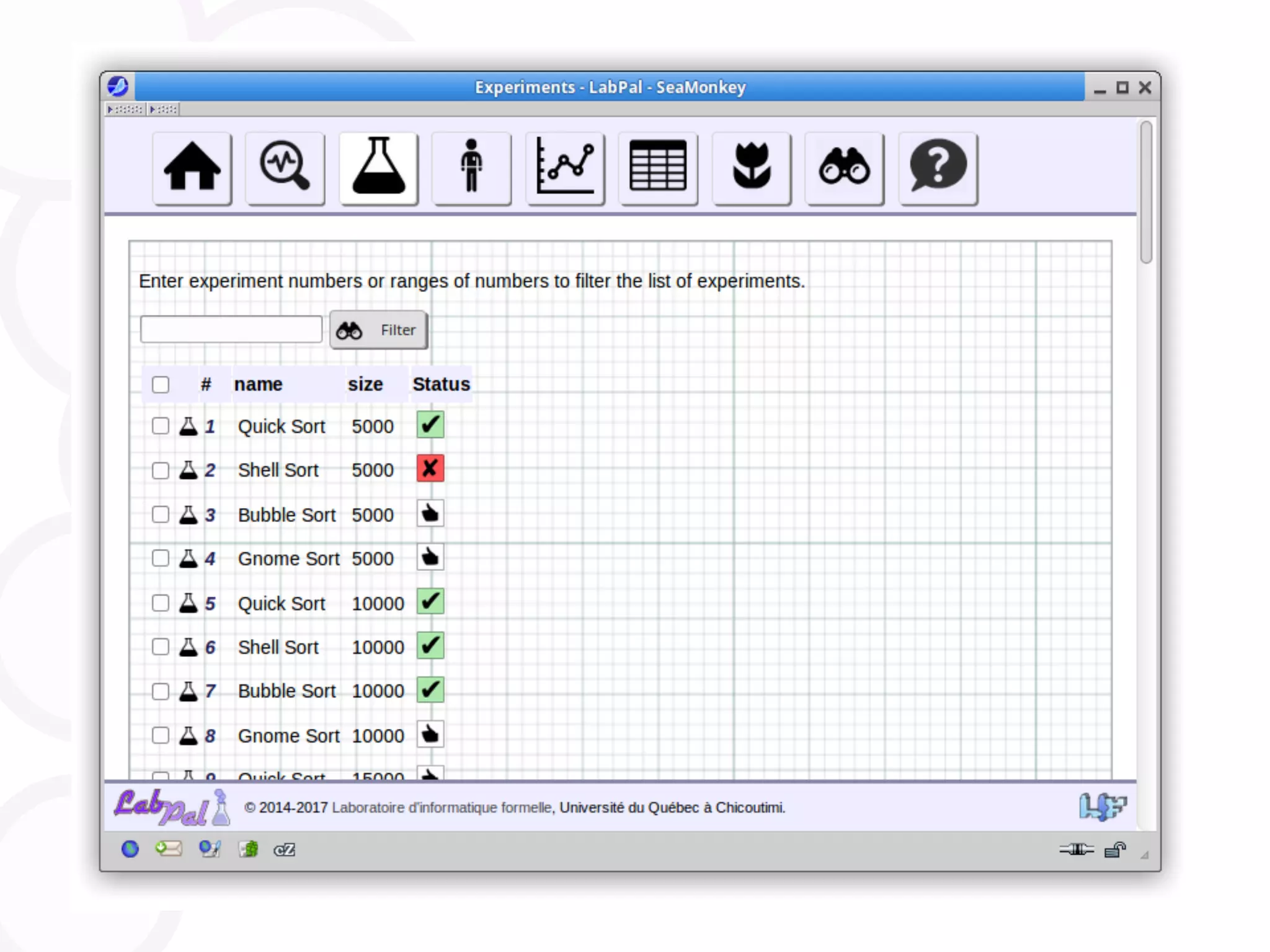
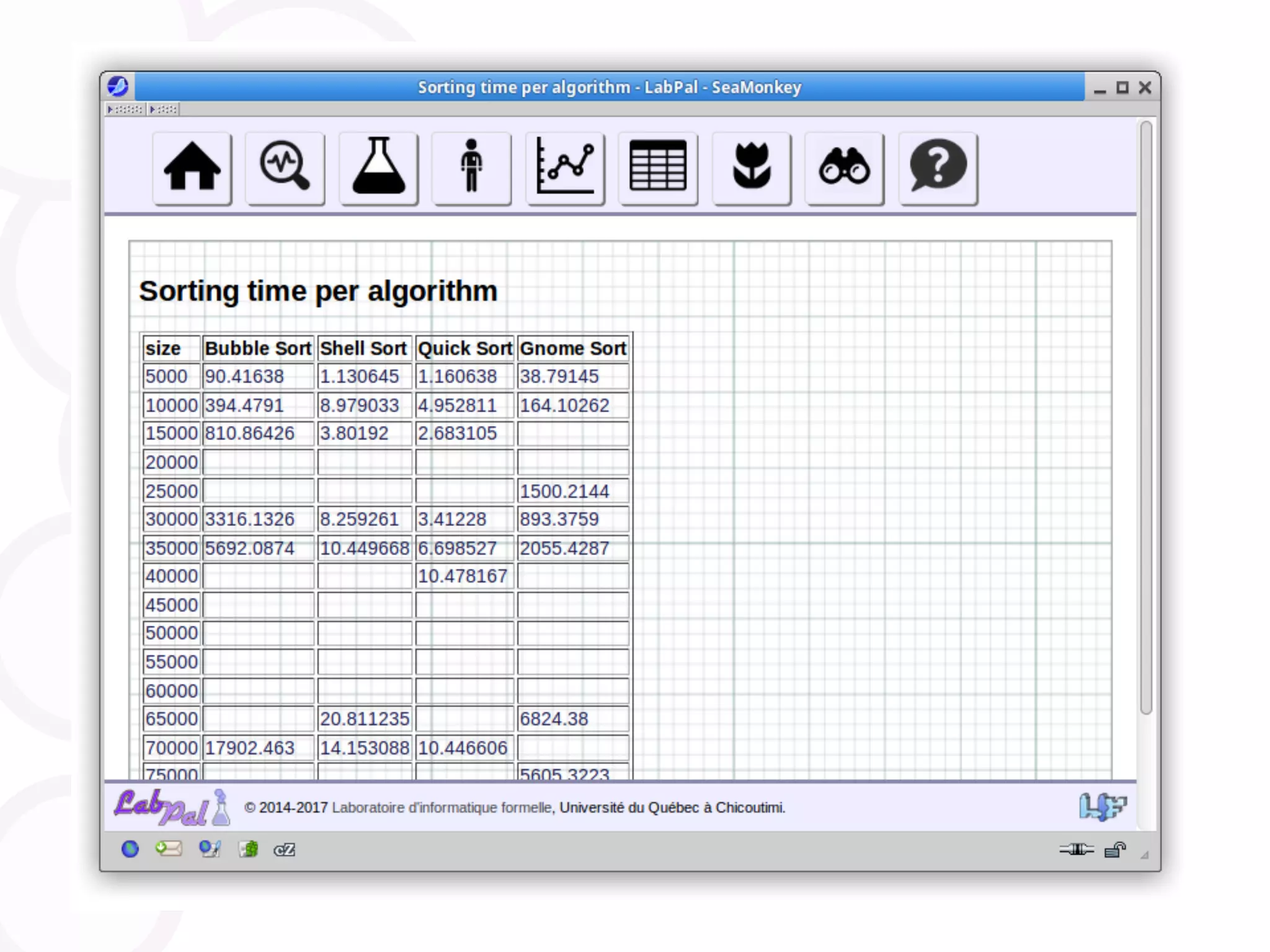
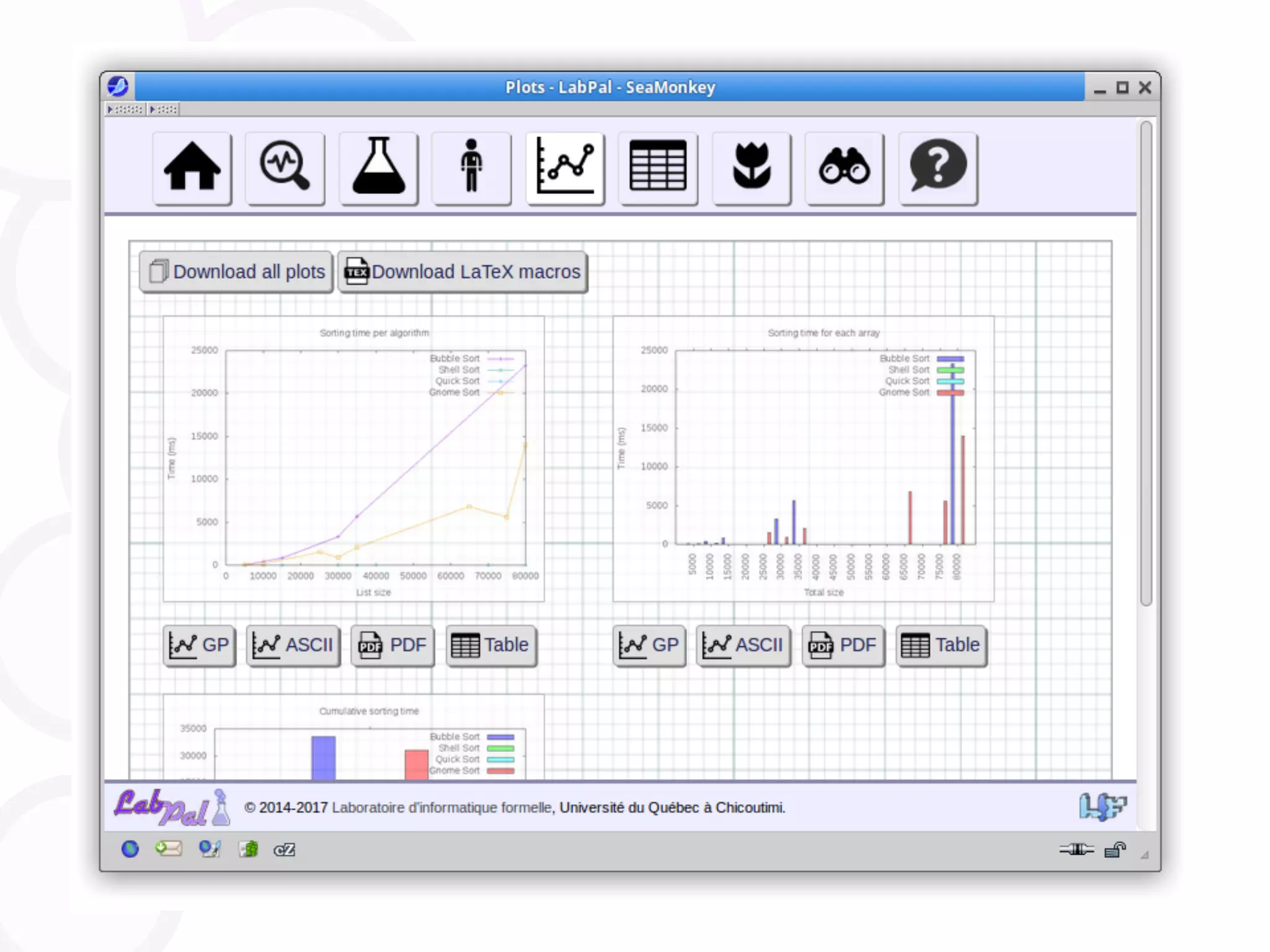
![E1 t=2 x=[3,1,0.3] u=http://... k=0.239 z=["foo","bar"] E1 t=5 x=[6,2,0.2] u=http://... E2q=0 f="foo" ... t z b SUM JOIN Track any cell of any table al the way up to the experiments that enter in the production of that value.](https://image.slidesharecdn.com/labpal-slides-171207151040/75/LabPal-Repeatable-Computer-Experiments-Made-Easy-ACM-Workshop-Talk-13-2048.jpg)
![E1 t=2 x=[3,1,0.3] u=http://... k=0.239 z=["foo","bar"] E1 t=5 x=[6,2,0.2] u=http://... E2q=0 f="foo" ... t z b SUM JOIN Track any cell of any table al the way up to the experiments that enter in the production of that value.](https://image.slidesharecdn.com/labpal-slides-171207151040/75/LabPal-Repeatable-Computer-Experiments-Made-Easy-ACM-Workshop-Talk-14-2048.jpg)
![E1 t=2 x=[3,1,0.3] u=http://... k=0.239 z=["foo","bar"] E1 t=5 x=[6,2,0.2] u=http://... E2q=0 f="foo" ... t z b SUM JOIN Track any cell of any table al the way up to the experiments that enter in the production of that value.](https://image.slidesharecdn.com/labpal-slides-171207151040/75/LabPal-Repeatable-Computer-Experiments-Made-Easy-ACM-Workshop-Talk-15-2048.jpg)
![E1 t=2 x=[3,1,0.3] u=http://... k=0.239 z=["foo","bar"] E1 t=5 x=[6,2,0.2] u=http://... E2q=0 f="foo" ... t z b SUM JOIN Track any cell of any table al the way up to the experiments that enter in the production of that value.](https://image.slidesharecdn.com/labpal-slides-171207151040/75/LabPal-Repeatable-Computer-Experiments-Made-Easy-ACM-Workshop-Talk-16-2048.jpg)
![E1 t=2 x=[3,1,0.3] u=http://... k=0.239 z=["foo","bar"] E1 t=5 x=[6,2,0.2] u=http://... E2q=0 f="foo" ... t z b SUM JOIN Track any cell of any table al the way up to the experiments that enter in the production of that value.](https://image.slidesharecdn.com/labpal-slides-171207151040/75/LabPal-Repeatable-Computer-Experiments-Made-Easy-ACM-Workshop-Talk-17-2048.jpg)
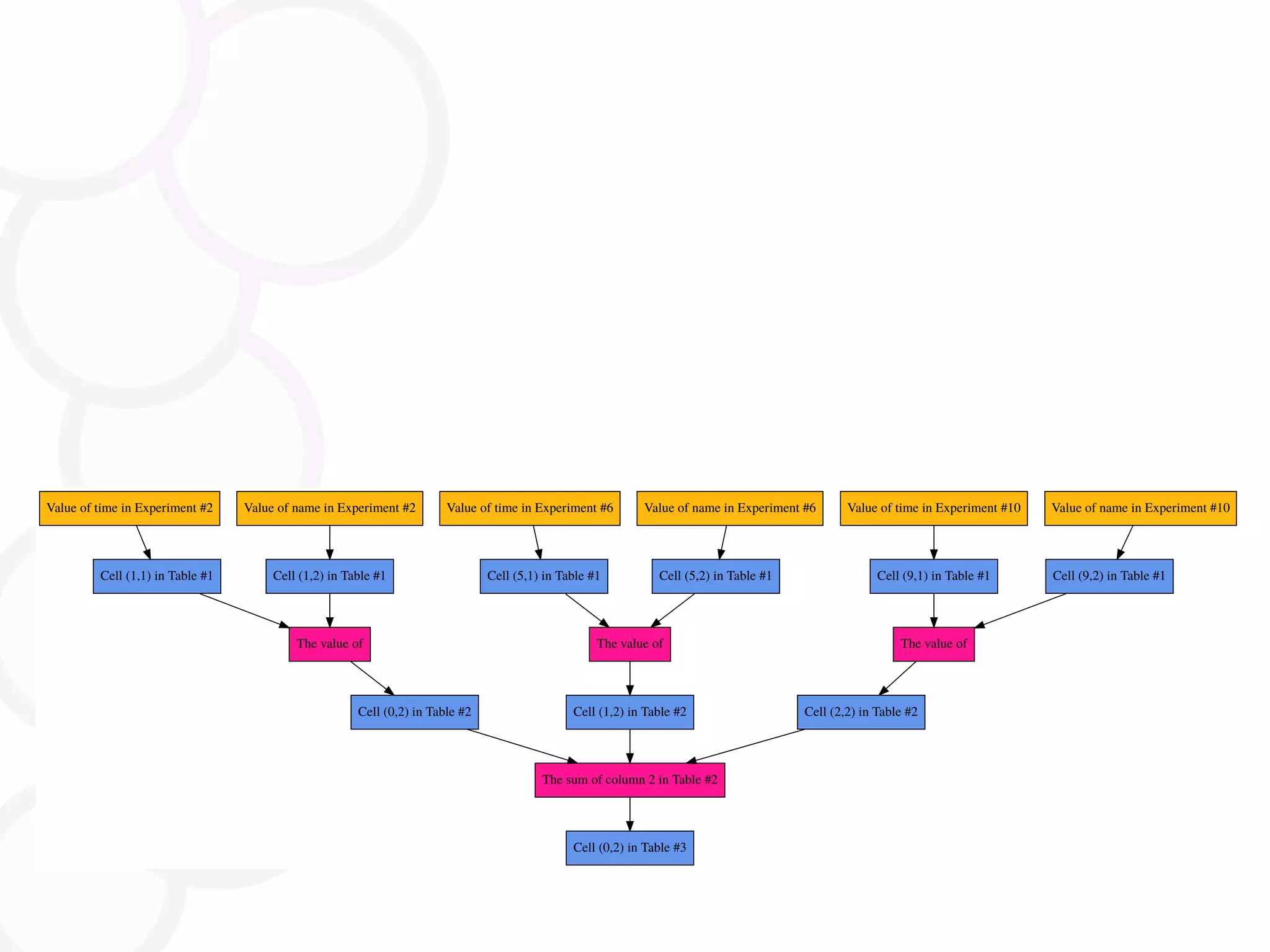

![E1 t=2 x=[3,1,0.3] u=http://... k=0.239 z=["foo","bar"] E1 t=5 x=[6,2,0.2] u=http://... E2q=0 f="foo" ... t z b SUM JOIN Track any cell of any table al the way up to the experiments that enter in the production of that value. T6.2.4 E0.z.0 Each individual datapoint is assigned a unique ID, called the LabPal Datapoint Identifier (LDI).](https://image.slidesharecdn.com/labpal-slides-171207151040/75/LabPal-Repeatable-Computer-Experiments-Made-Easy-ACM-Workshop-Talk-20-2048.jpg)
![E1 t=2 x=[3,1,0.3] u=http://... k=0.239 z=["foo","bar"] E1 t=5 x=[6,2,0.2] u=http://... E2q=0 f="foo" ... t z b SUM JOIN Track any cell of any table al the way up to the experiments that enter in the production of that value. T6.2.4 E0.z.0 Each individual datapoint is assigned a unique ID, called the LabPal Datapoint Identifier (LDI). doi.org/10.1145/309.308/](https://image.slidesharecdn.com/labpal-slides-171207151040/75/LabPal-Repeatable-Computer-Experiments-Made-Easy-ACM-Workshop-Talk-21-2048.jpg)

